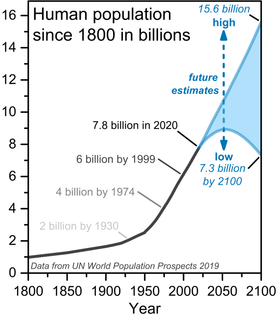Population growth
Population growth is the rate at which a population grows or expands. For example, if a population increased from 100 to 110 in a year, then it would have had a population growth of 10% per year.

| Population[1] | ||
|---|---|---|
| Years passed | Year | Billion |
| – | 1800 | 1 |
| 127 | 1927 | 2 |
| 33 | 1960 | 3 |
| 14 | 1974 | 4 |
| 13 | 1987 | 5 |
| 12 | 1999 | 6 |
| 12 | 2011 | 7 |
| 12 | 2023* | 8 |
| 14 | 2037* | 9 |
| 18 | 2055* | 10 |
| 33 | 2088* | 11 |
| *World Population Prospects 2017 (United Nations Population Division) | ||
World population
changeWorld population has been rising since the end of the Black Death, around the year 1350.[2]
Population began growing rapidly in the Western world during the industrial revolution. Several factors were notable: the coming of modern agriculture, and the control of epidemic diseases (black death, cholera, typhus). Modern water engineering brought clean water to many large cities. Deaths from world wars, especially WWI, reversed the trend, but only for a while.
The most significant increase in the world's population has been since the 1950s in Asia and Latin America. Medical advances,[3] and increases in farming,[4] have been the main causes.
A single example is both astonishing and revealing. Since 1945, half the forests of Indonesia have been replaced with farmland. As late as 1900, Indonesia was still a densely forested country: forests covered 84 percent of the total land area. Deforestation became serious in the 1970s, and has gone faster since then. About 170 million hectares (estimated in 1900) decreased to less than 100 million hectares by the end of the 20th century.[5] In 2008, it was estimated that tropical rainforests in Indonesia would be logged out in a decade.[6] Of the total logging in Indonesia, up to 80% is said to be done illegally.[7]
Related pages
changeFurther reading
change- "Agriculture, plant physiology, and human population growth: past, present, and future" (PDF). Lincoln Taiz - Theoretical and Experimental Plant Physiology (2013), University of California.
- YAN Kun(2011). The tendency equation of the population and its limit value in the United Kingdom (Brief annotation of the connection equation(R)), Xi'an: Xi'an Modern Nonlinear Science Applying Institute.
References
change- ↑ "United Nations - World Population Prospects 2017". Archived from the original on 2018-03-22. Retrieved 2017-07-07.
- ↑ "Black death 'discriminated' between victims". Australian Broadcasting Corporation. 29 January 2008. Archived from the original on 20 December 2016. Retrieved 2008-11-03.
- ↑ Greenwood, B. (19 June 2014). "The contribution of vaccination to global health: past, present and future". Philosophical Transactions of the Royal Society of London. Series B, Biological Sciences. 369 (1645). Philosophical Transactions of the Royal Society: 20130433. doi:10.1098/rstb.2013.0433. PMC 4024226. PMID 24821919.
- ↑ "The Neolithic Demographic Transition, Population Pressure and Cultural Change". Jean-Pierre Bocquet-Appel (French National Centre for Scientific Research). Comparative Civilizations Review. Volume 58 No. 58, Article 6. Brigham Young University.
- ↑ Matthews, Emilly (ed): The State of Forests Indonesia, Bogor 2002, Retrieved 28 May 2010
- ↑ China is black hole of Asia's deforestation, Asia News, 24 March 2008
- ↑ Riskanalys av glas, järn, betong och gips Archived 13 May 2012 at the Wayback Machine 29 March 2011. s.19–20 (in Swedish)
Other websites
change- "Agriculture and Human Population Growth". CK-12 Foundation.